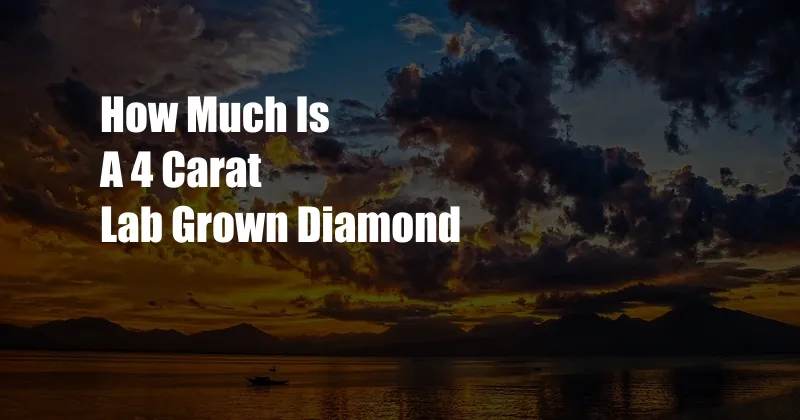
How Much is a 4 Carat Lab Grown Diamond?
Have you ever been fascinated by the brilliance of diamonds but hesitated to purchase one due to its hefty price tag? If so, you’re not alone. Diamonds have long been associated with luxury and exclusivity, making them inaccessible for many people. However, the advent of lab-grown diamonds has revolutionized the diamond industry, offering an affordable alternative to their natural counterparts.
Lab-grown diamonds, also known as synthetic diamonds, share the same chemical composition, physical properties, and optical characteristics as mined diamonds. The only difference lies in their origin—lab-grown diamonds are created in controlled laboratory conditions, while mined diamonds are formed naturally over millions of years.
Price of a 4 Carat Lab Grown Diamond
The price of a 4 carat lab-grown diamond varies depending on several factors, including the diamond’s cut, clarity, color, and carat weight. However, as a general rule, lab-grown diamonds are significantly more affordable than natural diamonds of the same size and quality.
According to the International Gemological Institute (IGI), the average price range for a 4 carat lab-grown diamond with a round brilliant cut, VS clarity, and G color is between $10,000 and $20,000. In comparison, a natural diamond with the same specifications would cost around $50,000 to $100,000.
Factors Affecting the Price of Lab Grown Diamonds
The following factors can affect the price of a 4 carat lab-grown diamond:
- Carat Weight: The price of a lab-grown diamond increases with its carat weight.
- Cut: The cut of a diamond determines its brilliance, fire, and scintillation. Lab-grown diamonds can be cut into various shapes, including round brilliant, princess, cushion, and emerald.
- Clarity: Clarity refers to the number and visibility of inclusions in a diamond. Lab-grown diamonds can be found with various clarity grades, from flawless to included.
- Color: The color of a diamond is determined by the presence of trace elements. Lab-grown diamonds range in color from colorless (D) to yellow (Z).
Tips for Buying a 4 Carat Lab Grown Diamond
If you’re considering purchasing a 4 carat lab-grown diamond, here are a few tips to help you make an informed decision:
- Do your research: Familiarize yourself with the 4Cs of diamond quality (carat, cut, clarity, color) and how they affect the price.
- Shop around: Compare prices from multiple retailers to ensure you’re getting the best deal.
- Consider your budget: Determine your budget before you start shopping and stick to it.
- Get a certificate: Always ask for a certificate from a reputable gemological laboratory, such as the IGI or the Gemological Institute of America (GIA), to ensure the diamond you’re buying is genuine.
FAQs About 4 Carat Lab Grown Diamonds
Q: Are lab-grown diamonds as valuable as natural diamonds?
A: While lab-grown diamonds share the same physical and chemical properties as natural diamonds, they have a lower market value due to their lab-created origin.
Q: Can lab-grown diamonds be used for engagement rings?
A: Yes, lab-grown diamonds are becoming increasingly popular for engagement rings. They offer the same beauty and brilliance as natural diamonds at a fraction of the cost.
Conclusion
If you’ve been dreaming of owning a large, sparkling diamond without breaking the bank, a 4 carat lab-grown diamond is an excellent choice. While lab-grown diamonds may not hold the same historical value or emotional significance as mined diamonds, they offer an affordable and eco-friendly alternative. Whether you’re looking for an engagement ring, a special gift, or simply a piece of jewelry to mark a milestone, a lab-grown diamond can provide the same dazzling beauty and allure as a natural diamond.
Are you intrigued by the allure of lab-grown diamonds? Let us know if you have any questions or would like to learn more about these captivating gemstones.